Posts Tagged: stick insects
Lawn-pocalypse! Surviving Drought
Ah, summer! The season of sunburns, pool parties, and… lawn droughts. If your once lush, green carpet now looks like a crunchy brown doormat, you're not alone. Let's dive into why your yard is staging a dramatic death scene and what you can do to...

Bermuda grass and weeds overtaking drought stressed turf grass.
Hands Down or Hands Up, They're Favorites
Hands down, or hands up, those walking sticks in the Bohart Museum of Entomology's live petting zoo are favorites among children and adults alike. The walking sticks, or stick insects, belong to the order Phasmatodea. The Phasmids, a word...
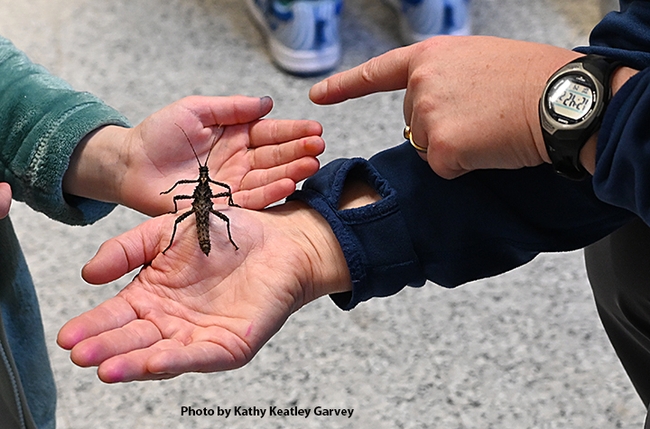
A walking stick switches to another hand during the recent Bohart Museum of Entomology open house. (Photo by Kathy Keatley Garvey)
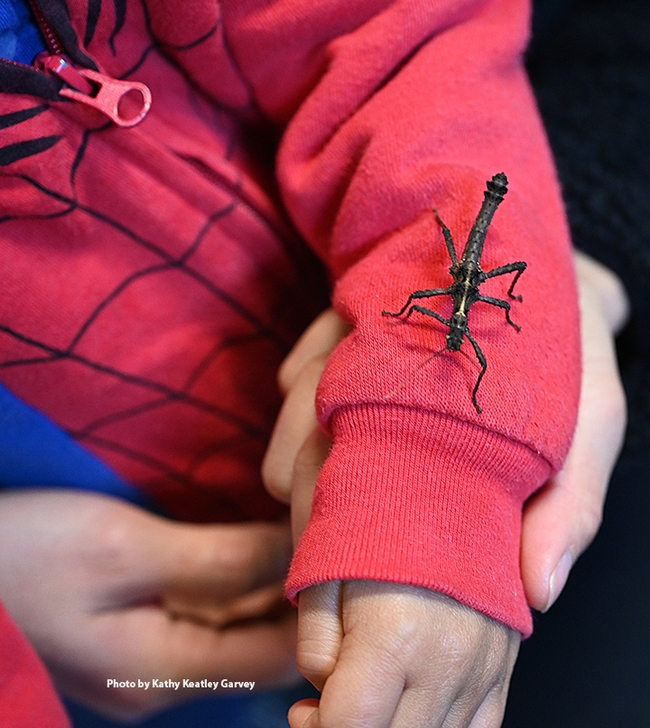
A walking stick heads down a youngster's sleeve. (Photo by Kathy Keatley Garvey)
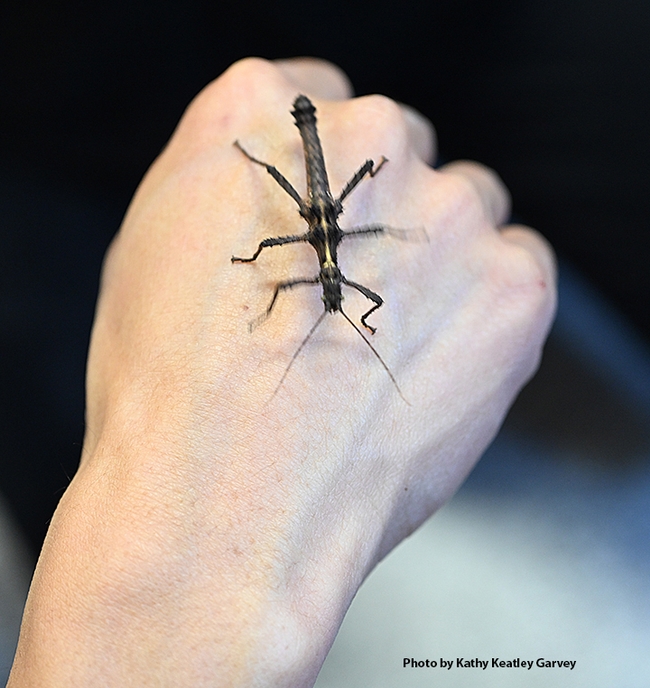
A walking stick descends a hand. (Photo by Kathy Keatley Garvey)
Booking Insects at Vacaville Public Library: Bring 'em On!
It's so quiet at times that you can almost hear a bee buzz or a walking stick walk or a Madagascar hissing cockroach hiss. The audience, ranging from toddlers to teens to senior citizens, are inside the the Vacaville Public Library. Some...
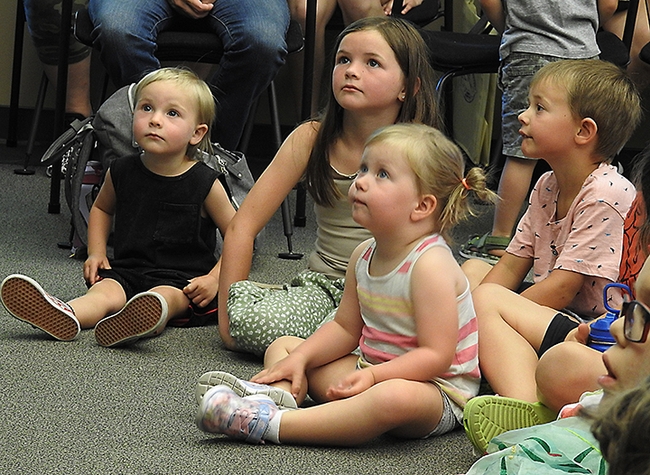
The Bohart Museum of Entomology insect presentation fascinates these youngsters at the Vacaville Public Library. (Photo by Kathy Keatley Garvey)
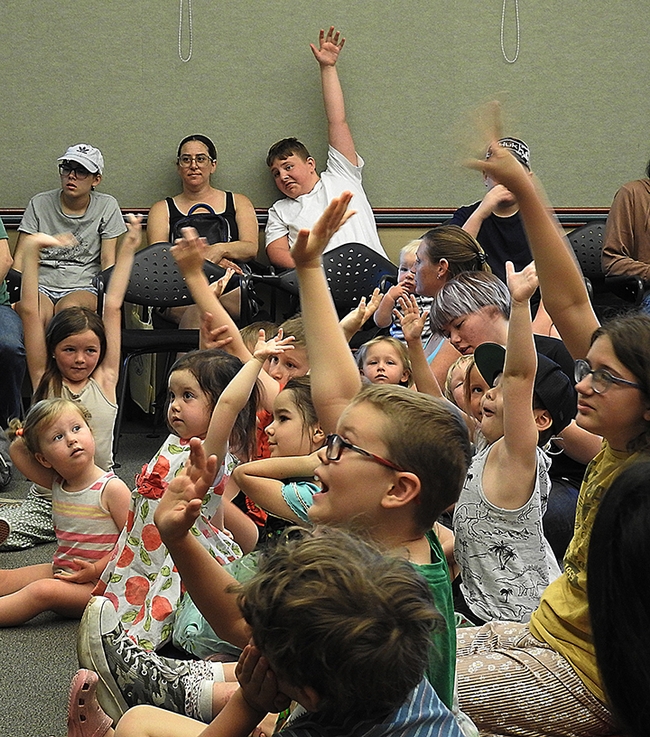
How many of you like insects? Hands shoot up at the Bohart Museum presentation at the Vacaville Public Library. (Photo by Kathy Keatley Garvey)
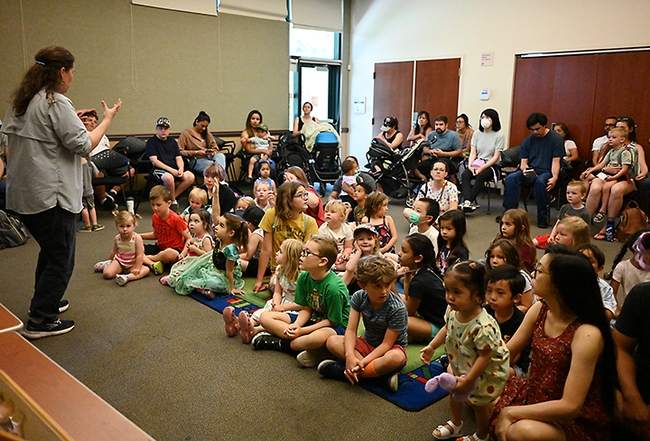
Tabatha Yang, the Bohart Museum of Entomology's education and outreach coordinator, discusses the diversity of insects to a diverse crowd. (Photo by Kathy Keatley Garvey)
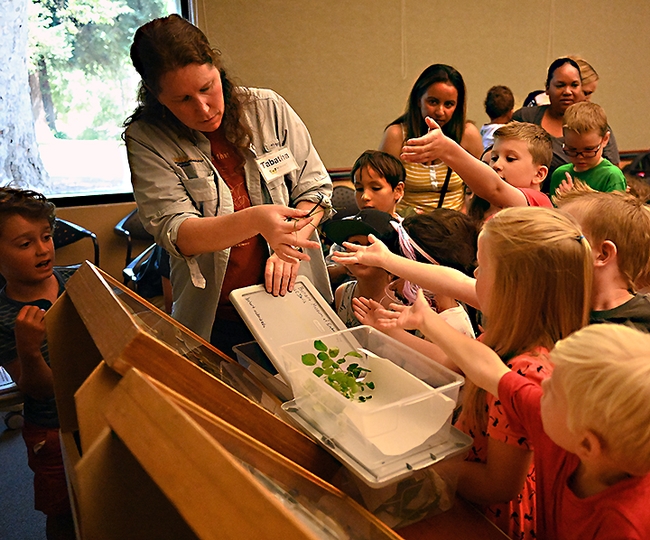
Tabatha Yang hands out insects from the Bohart Museum of Entomology's petting zoo to eager youngsters. (Photo by Kathy Keatley Garvey)
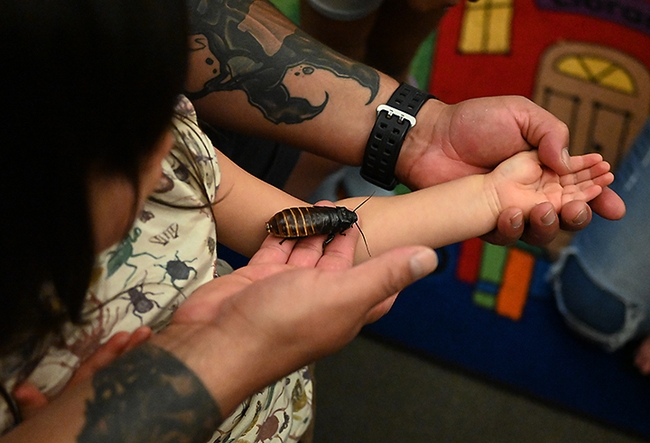
A Madagascar hissing cockroach draws attention. (Photo by Kathy Keatley Garvey)

One of the most popular insects: a Great Thin Stick Insect (Ramulus nenatodes). (Photo by Kathy Keatley Garvey)
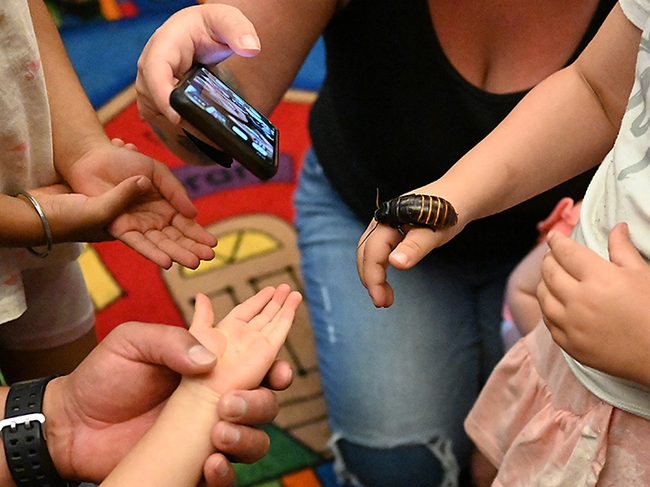
Eager hands await their turn. (Photo by Kathy Keatley Garvey)
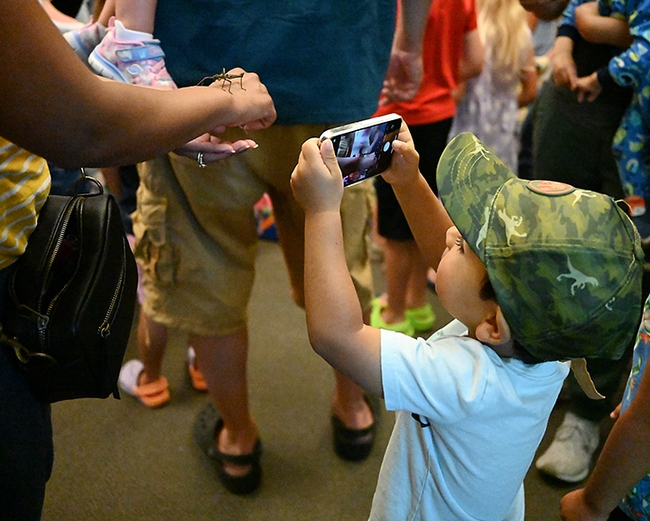
A pre-schooler takes an image of an insect with a borrowed cell phone. (Photo by Kathy Keatley Garvey)
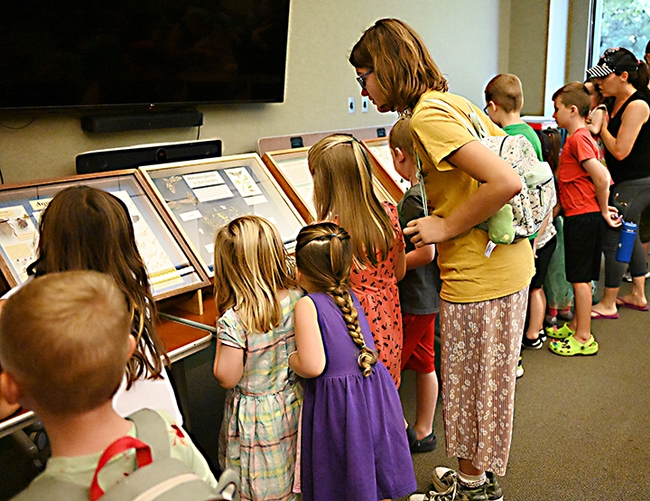
A line of viewers at the display of the Bohart Museum's pinned specimens, gathered from all over the world. (Photo by Kathy Keatley Garvey)
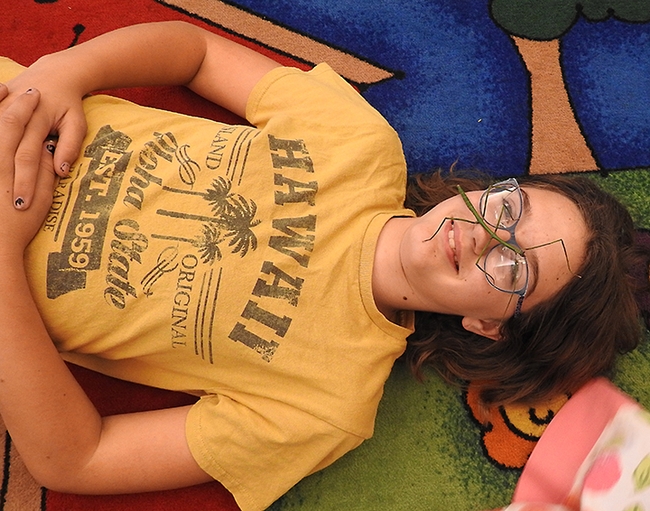
Grace Murray, 13, relaxing with a stick insect. Her mother, Kristen Murray, is a children's librarian. (Photo by Kathy Keatley Garvey)
Climate-Change Resources
University of California UC ANR Green Blog (Climate Change and Other Topics) https://ucanr.edu/blogs/Green/index.cfm?tagname=climate%20change (full index)
Examples:
- Save Trees First: Tips to Keep Them Alive Under Drought https://ucanr.edu/b/~CdD
- Landscaping with Fire Exposure in Mind: https://ucanr.edu/b/~G4D
- Cities in California Inland Areas Must Make Street Tree Changes to adapt to Future Climate https://ucanr.edu/b/~oF7
Drought, Climate Change and California Water Management Ted Grantham, UC Cooperative Extension specialist (23 minutes) https://youtu.be/dlimj75Wn9Q
Climate Variability and Change: Trends and Impacts on CA Agriculture Tapan Pathak, UC Cooperative Extension specialist (24 minutes) https://youtu.be/bIHI0yqqQJc
California Institute for Water Resources (links to blogs, talks, podcasts, water experts, etc.) https://ciwr.ucanr.edu/California_Drought_Expertise/
UC ANR Wildfire Resources (publications, videos, etc.) https://ucanr.edu/News/For_the_media/Press_kits/Wildfire/ (main website)
-UC ANR Fire Resources and Information https://ucanr.edu/sites/fire/ (main website)
-Preparing Home Landscaping https://ucanr.edu/sites/fire/Prepare/Landscaping/
UC ANR Free Publications https://anrcatalog.ucanr.edu/ (main website)
- Benefits of Plants to Humans and Urban Ecosystems: https://anrcatalog.ucanr.edu/pdf/8726.pdf
-Keeping Plants Alive Under Drought and Water Restrictions (English version) https://anrcatalog.ucanr.edu/pdf/8553.pdf
(Spanish version) https://anrcatalog.ucanr.edu/pdf/8628.pdf
- Use of Graywater in Urban Landscapes https://anrcatalog.ucanr.edu/pdf/8536.pdf
- Sustainable Landscaping in California https://anrcatalog.ucanr.edu/pdf/8504.pdf
Other (Non-UC) Climate Change Resources
Urban Forests and Climate Change. Urban forests play an important role in climate change mitigation and adaptation. Active stewardship of a community's forestry assets can strengthen local resilience to climate change while creating more sustainable and desirable places to live. https://www.fs.usda.gov/ccrc/topics/urban-forests
Examining the Viability of Planting Trees to Mitigate Climate Change (plausible at the forest level) https://climate.nasa.gov/news/2927/examining-the-viability-of-planting-trees-to-help-mitigate-climate-change/
Reports and other information resources coordinated under the auspices of the United Nations and produced through the collaboration of thousands of international scientists to provide a clear and up to date view of the current state of scientific knowledge relevant to climate change. United Nations Climate Action
Scientific reports, programs, action movements and events related to climate change. National Center for Atmospheric Research (National Science Foundation)
Find useful reports, program information and other documents resulting from federally funded research and development into the behavior of the atmosphere and related physical, biological and social systems. Search and find climate data from prehistory through to an hour ago in the world's largest climate data archive. (Formerly the "Climatic Data Center") National Centers for Environmental Information (NOAA)
Think tank providing information, analysis, policy and solution development for addressing climate change and energy issues (formerly known as the: "Pew Center on Global Climate Change"). Center for Climate & Energy Solutions (C2ES)
Mapping Resilience: A Blueprint for Thriving in the Face of Climate Disaster. The Climate Adaptation Knowledge Exchange (CAKE) was launched in July 2010 and is managed by EcoAdapt, a non-profit with a singular mission: to create a robust future in the face of climate change by bringing together diverse players to reshape planning and management in response to rapid climate change. https://www.cakex.org/documents/mapping-resilience-blueprint-thriving-face-climate-disaster
Cal-Adapt provides a way to explore peer-reviewed data that portrays how climate change might affect California at the state and local level. We make this data available through downloads, visualizations, and the Cal-Adapt API for your research, outreach, and adaptation planning needs. Cal-Adapt is a collaboration between state agency funding programs, university and private sector researchers https://cal-adapt.org/
Find reports, maps, data and other resources produced through a confederation of the research arms of 13 Federal departments and agencies that carry out research and develop and maintain capabilities that support the Nation's response to global change. Global Change (U.S. Global Change Research Program)
The Pacific Institute is a global water think tank that combines science-based thought leadership with active outreach to influence local, national, and international efforts to develop sustainable water policies. https://pacinst.org/our-approach/
Making equity real in climate adaptation and community resilience policies and programs: a guidebook. https://greenlining.org/publications/2019/making-equity-real-in-climate-adaption-and-community-resilience-policies-and-programs-a-guidebook/
Quarterly CA Climate Updates and CA Drought Monitor Maps (updated each Thursday) https://www.drought.gov/documents/quarterly-climate-impacts-and-outlook-western-region-june-2022
How a Newly Described Bacteria Species Got the Kimsey Name
A newly described bacteria species found more than a decade ago inside the gut of a stick insect housed in the Bohart Museum of Entomology petting zoo, now bears the name of two very surprised UC Davis entomologists. Meet Chryseobacterium kimseyorum,...

Former UC Davis doctoral student Matan Shelomi described a new bacteria species from the gut of a Giant New Guinea Stick Insect, Eurycantha calcarata. This is a E. calcarata from the Bohart Museum. Shelomi named the bacteria after UC Davis faculty members Lynn and Bob Kimsey. (Photo by Kathy Keatley Garvey)

